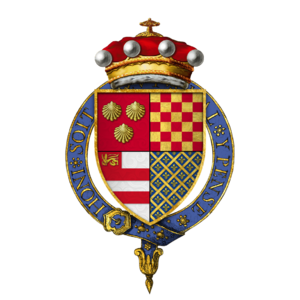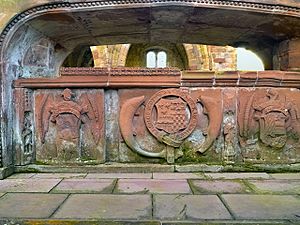Thomas Dacre, 2nd Baron Dacre facts for kids
Quick facts for kids
Thomas Dacre, 2nd Baron Dacre
|
|
|---|---|

Arms of Sir Thomas Dacre, 2nd Baron Dacre, KG
|
|
| Born | 25 November 1467 Gilsland, Cumberland, England. |
| Died | 24 October 1525 Borders of Scotland and England. |
| Title | Baron Dacre of Gilsland |
| Tenure | 30 May 1485 – 24 October 1525 |
| Nationality | English |
| Residence | Naworth Castle |
| Spouse(s) | Elizabeth de Greystoke, ''suo jure'' 6th Baroness Greystoke |
| Issue | Mabel Dacre, Baroness Scrope of Bolton Elizabeth Dacre, Lady Musgrave William Dacre, 3rd Baron Dacre Anne Dacre, Baroness Conyers Mary Dacre, Countess of Shrewsbury Hon. Humphrey Dacre Jane Dacre, Lady Tailboys |
| Parents | Humphrey Dacre, 1st Baron Dacre Mabel Parr |
|
|
|
Thomas Dacre, 2nd Baron Dacre of Gilsland (born November 25, 1467 – died October 24, 1525), was an important English nobleman and soldier. He was also a Knight of the Garter, which is a very special award given by the King. Thomas was the son of Humphrey Dacre, 1st Baron Dacre and Mabel Parr. Mabel was the great-aunt of Catherine Parr, who later became the sixth wife of King Henry VIII of England.
Contents
Becoming a Baron and Royal Service
Thomas Dacre was born in Cumberland, England. He was the oldest of nine children. When his father, Humphrey, passed away on May 30, 1485, Thomas became the Baron Dacre of Gilsland. This meant he inherited his father's title and lands.
Soon after becoming a baron, Thomas Dacre fought in the Battle of Bosworth Field on August 22, 1485. He was on the side of King Richard III of England, who was defeated and killed by Henry Tudor. Even though he fought against Henry Tudor, Thomas quickly made peace with the new king. This early support helped him gain King Henry VII's trust. In 1503, King Henry VII made him a Knight of the Bath. When Henry VIII became king in 1509, Thomas Dacre promised his loyalty to the new ruler.
Protecting the Borders
Thomas Dacre was very important in protecting the border between England and Scotland. In 1485, he was made a deputy of the Lord Warden of the Marches. This was a powerful job, like being in charge of border security. Later, he became the Warden of the Western Marches and then the Warden-general over all the borders in 1509.
In 1498, James IV of Scotland gave him permission to fish for salmon in the River Esk. He was allowed to build special fish traps called "garths." In return, he had to give some fish to the keeper of Lochmaben Castle each year.

Battle of Flodden and Scottish Affairs
Thomas Dacre and his soldiers fought bravely at the Battle of Flodden on September 9, 1513. This was a major battle where the Scottish army, led by King James IV, invaded England. The English army, led by Thomas Howard, won a huge victory, and King James IV was killed.
Dacre commanded a group called the "Border Lancers" during the battle. Their charge helped save another English commander, Lord Edmund Howard. The victory at Flodden made Dacre even more famous as a strong soldier. After the battle, Dacre found the body of the Scottish king. He later wrote that the Scottish people "love me worst of any Inglisheman living" because he found their king's body.
Dacre also played a role in Scottish politics after the battle. He communicated with Margaret Tudor, King James IV's widow and King Henry VIII's sister. He also worked to cause trouble for the Duke of Albany, who was a powerful figure in Scotland. Dacre even sent people to collect Margaret's money and jewels.
Building and Honors
In 1517, Dacre oversaw important repairs at Wark on Tweed Castle. He got money from Cardinal Wolsey and hired a master builder to design new defenses. By 1518, a new strong tower (called a donjon or keep) was finished. It was strong enough to hold large cannons.
In 1518, King Henry VIII honored Thomas Dacre by making him a Knight of the Garter. This was a very high honor. In 1520, Dacre was present at a famous meeting between King Henry VIII and Francis I of France, known as the Field of the Cloth of Gold.
Thomas Dacre passed away on October 24, 1525, after falling from his horse near the Scottish border. He was buried in his family's tomb at Lanercost Priory. By the time he died, he owned a lot of land in England. Much of this land came from marriages with wealthy heiresses and gifts from Kings Henry VII and Henry VIII.
Thomas Dacre was also known as "the Builder Dacre." He built the main entrance of Naworth Castle, which was his family's home. Above the entrance, he placed his family's coat of arms and their motto: Fort en Loialte, which means "Strong in Loyalty" in old French.
Family Life
Around 1488, Thomas Dacre married Elizabeth Greystoke. Elizabeth was born on July 10, 1471, and died on August 14, 1516. She was the daughter of Sir Robert de Greystoke. Elizabeth was also the granddaughter and heiress of Ralph de Greystoke, meaning she inherited the title of Baroness Greystoke.
Thomas and Elizabeth had eight children:
- Mabel Dacre (around 1490–1533), who married Henry Scrope, 7th Baron Scrope of Bolton. Their grandson, Henry Scrope, later took care of Mary, Queen of Scots, when she came to England in 1568.
- Elizabeth Dacre (1495-1538), who married Sir Thomas Musgrave.
- William Dacre, 3rd Baron Dacre (April 29, 1500 – November 18, 1563), who inherited his father's title.
- Anne Dacre (around 1501 – April 21, 1548), who married Christopher Conyers, 2nd Baron Conyers.
- Mary Dacre (around 1502 – March 29, 1538), who married Francis Talbot, the 5th Earl of Shrewsbury.
- Humphrey Dacre, who married Isabel Martindale.
- Jane Dacre, who married Lord Tailboys.
Later Dacre Influence
Thomas Dacre also had an illegitimate son, also named Thomas Dacre, who was nicknamed "the Bastard." This Thomas Dacre led a small group of English border soldiers against an invading Scottish force in 1542. His success helped lead to the Scottish defeat at the Battle of Solway Moss. This Thomas Dacre was given land and started another branch of the Dacre family.
There were also letters between Thomas Dacre and Lady Maud Parr about a possible marriage between his grandson, Henry le Scrope, and her daughter, Catherine Parr. This marriage never happened, but Catherine Parr later became queen consort to King Henry VIII of England.
See also
- Naworth Castle, the historic home of the Dacre family

